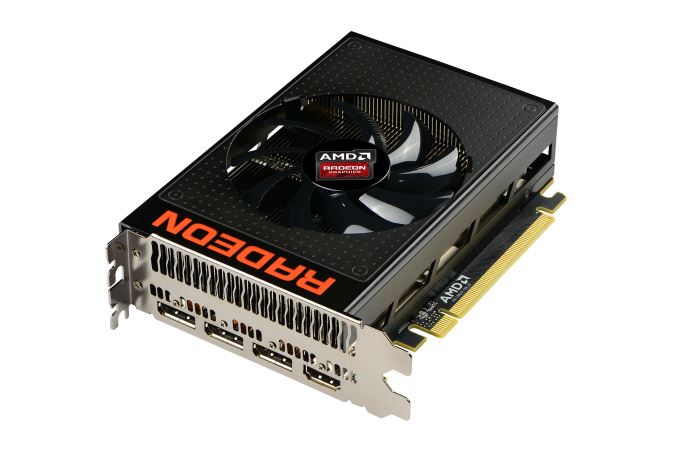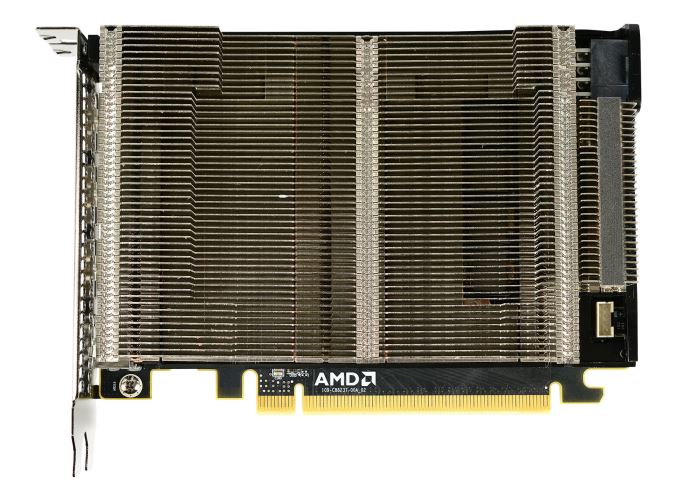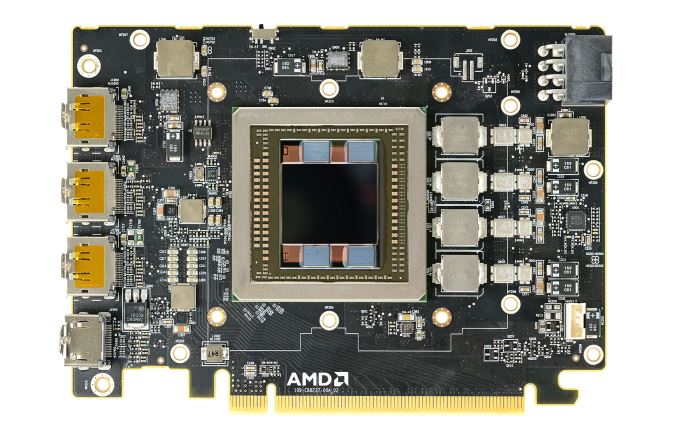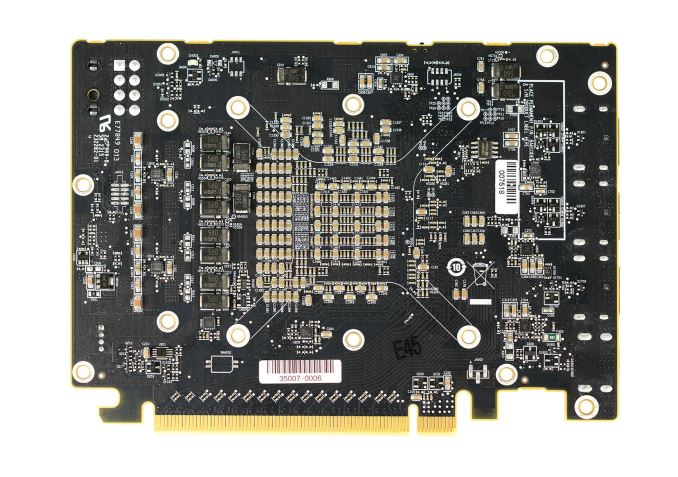The AMD Radeon R9 Nano Review: The Power of Size
by Ryan Smith on September 10, 2015 8:00 AM ESTMeet The Radeon R9 Nano
6 inch video cards are by no means a new thing in the GPU space, however these are traditionally lower-end products that need neither a large cooler nor an extensive power delivery system. As a result the R9 Nano is something of an interesting aberration, packing a lot more power and a lot more technology into half a foot of video card than what we normally see.
Starting as always from the top, the R9 Nano measures 6” long, which is actually a bit shorter than the full length the Mini-ITX standard allows. Responsibility for cooling the card falls to the R9 Nano’s new open air cooler, an aggressive design that has been specifically tailored to allow the card to effectively dissipate 175W of heat in such a small space.
The overall design of the R9 Nano’s cooler is best described as a combination open-air and half-blower hybrid. The design is technically open-air, employing a single axial fan to cool the card. However with only a single fan AMD has been able to align the heatsink fins horizontally and then place the fan in the center of the heatsink. The end result is that roughly half of the heat produced by the card is vented outside of the case, similar to a full blower, while the other half of the heat is vented back into the case. This reduces (though doesn’t eliminate) the amount of hot air being recycled by the card.
The heatsink itself is composed of aluminum and runs virtually the entire length of the card. This is technical a two-piece heatsink, with the primary heatsink composing the bulk of the card, while a much smaller secondary heatsink it found towards the far end of the card and mounted on top of a heatpipe.
Drilling down, we find that the primary heatsink is fed by a combination vapor chamber and heatpipe design. A copper vapor chamber serves to draw heat away from the Fiji GPU and HBM stacks, and then heatpipes are used to better distribute heat to the rest of the heatsink. The use of a vapor chamber in the R9 Nano makes a lot of sense given the fact that vapor chambers are traditionally the most efficient heatsink base type, however the R9 Nano is also unique in that we typically don’t see vapor chambers and heatpipes used together. Other designs such as the high-end GeForce series use a single large vapor chamber across the entire heatsink base, so among reference cards at least the R9 Nano stands alone in this respect. In this case given AMD’s design goals for size and noise, a vapor chamber will play a big part in helping the small card effectively and quietly dissipate 175W.
As for the physical PCB itself, as we can see AMD made it a relatively packed card in order to get the R9 Nano down to 6 inches. Compared to the R9 Fury X reference board, the biggest change here is that AMD has removed a fair bit of power circuitry to save space. By our count there are 4 VRM phases to feed the Fiji GPU, as opposed to the 6 found on R9 Fury X. Power delivery is handled by a single 8-pin PCIe power socket, which is becoming increasingly common, replacing the 2x 6-pin setup for 150W-225W cards.
Meanwhile to further shrink the overall PCB footprint, AMD has moved some of the remaining power delivery circuitry to the back of the card. The front of the card still contains the inductors and heat-sensitive MOSFETs, while a number of capacitors are on the rear of the card (and is why you won’t find a backplate).
Finally, for display I/O R9 Nano is unchanged from R9 Fury X. This means we’re looking at a DVI-free design, with 3x DisplayPort 1.2 and 1x HDMI 1.4 port all along a single row of the I/O bracket. Buyers looking to put together HTPCs will want to be especially mindful of the HDMI 1.4 port; while it's not necessarily a deal-breaker, it does mean that the R9 Nano can't fully drive 4Kp60 TVs, which are slowly but surely becoming more common.
Overall AMD is rather confident in their design for the R9 Nano. The heatsink is built to efficiently dissipate more heat than the 175W the card requires (despite the small size), and as a result we never see the R9 Nano thermally throttle under normal operation. The card’s thermal throttle point is 85C, and in our testing the card never passed 75C, exactly as AMD promised us. What ends up limiting the R9 Nano’s performance then is exactly as expected: the power throttling.
















284 Comments
View All Comments
Michael Bay - Thursday, September 10, 2015 - link
Do they pay you, at least?palindrome - Thursday, September 10, 2015 - link
AMD can't afford me.DigitalFreak - Thursday, September 10, 2015 - link
Maybe not, but I hear they pass your mother around at parties.at80eighty - Friday, September 11, 2015 - link
ughD. Lister - Saturday, September 12, 2015 - link
@DigitalFreakThat was needlessly rude.
lmcd - Saturday, September 12, 2015 - link
I can't wait for a comment system where I can report you, DigitalFreak.Besides, palindrome's comments have all been reasonable, even if a tad biased.
medi03 - Friday, September 11, 2015 - link
"R9 Nano demonstrates slightly better performance than GTX 980 –around 5% at 2560x1440"TheCurve - Thursday, September 10, 2015 - link
Thanks for the quality review, Ryan. Easy to read, yet descriptive when it counts. And whoever did the editing did well, I didn't notice any typos or other weirdness. For what it's worth, I thought you were very impartial. You praised the Nano when it deserved it and criticized it when it came up short. I'm not sure what else these rude commenters want. I have a feeling they didn't really read the review in its entirety -- probably just skimmed.lmcd - Saturday, September 12, 2015 - link
Seconded since I'm too lazy to type a paragraph.RandSec - Thursday, September 10, 2015 - link
"Energy efficiency compared to NVIDIA’s GM204 lineup (GTX 980/970) is not much better, which for AMD represents a significant improvement, but also means they don’t have any kind of clear advantage over NVIDIA."Although commonly accepted, this comment reveals a lack of understanding of two different design directions. In the past that was seen as reasonable because benchmarks. But benchmarks are inherently architecturally biased, in this case for DX11. That has resulted in users buying Nvidia while not understanding the tradeoffs and potential consequences.
AMD and Nvidia made different design decisions. Nvidia apparently designed for DX11, which used almost no GPU compute, and so removed much of the compute from their chips, making them smaller and "more efficient." On DX11.
In contrast, AMD seems to have designed for GPU compute, thus making their chips necessarily larger and less "efficient" on DX11. But now we see that DX12 allows and even requires more GPU compute, which the AMD GCN chips can handle.
OF COURSE Nvidia will be "more efficient" if they do not put as much stuff on their chips. But that does not make them better, it instead makes them "brittle" in the sense of not being able to easily respond to change. In the end, Nvidia may benefit from users buying another board. But that is not only a clever consequence of Nvidia design and marketing, but also the reviewing press, who allowed this weakness to pass unnoticed and uncommented for years on end. As it turns out, it is easy to make an "efficient" device, when it does not have the parts needed for the future.